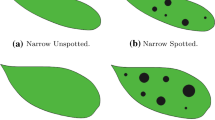Abstract
Flowers are a plant's most appealing and defining characteristic. As a result, flower recognition can assist in learning more about the plant. Color and shape are the two most distinguishing characteristics of flowers. These characteristics can be used to train the model so that it can recognize an unknown bloom in the future. It can be used to create image-based searching applications in the disciplines of botanical taxonomy, environmental monitoring systems, and multimedia. The paper's goal is to create a machine learning classifier for floral photos from the Oxford-17 dataset. For this, we tested two approaches: develo** a bespoke model from scratch and comparing the accuracies of different pre-trained models. Due to the tiny amount of the dataset, this was a difficult task to solve. The RegNetY 16GF model with pre-trained weights provided the best accuracy. The highest level of accuracy achieved was 93.4%.
Access this chapter
Tax calculation will be finalised at checkout
Purchases are for personal use only
Similar content being viewed by others
References
Yang B, Xu Y (2014) Applications of deep-learning approaches in horticultural research: a review
Nilsback M-E, Zisserman A (2006) A visual vocabulary for flower classification. In Proc CVPR 2:1447–1454
Nilsback M-E, Zisserman A (2007) Delving into the whorl of flower segmentation. In Proc BMVC 1:570–579
Nilsback M-E, Zisserman A (2008) Automated flower classification over a large number of classes
Pandey S, Dholay S (2019) An image processing approach for analyzing assessment of pavement distress.In: Innovations in Computer Science and Engineering. Springer, Singapore
Gürkaynak C, Arica N (2018) A case study on transfer learning in convolutional neural networks. In: 26th Signal Processing and Communications Applications Conference (SIU). IEEE
Sun Y, et al (2017) Deep learning for plant identification in natural environment. Computational intelligence and neuroscience
Cengıl E, Çinar A (2019) Multiple classification of flower images using transfer learning. In:: International Artificial Intelligence and Data Processing Symposium (IDAP). IEEE
Feng J, et al (2019) Flower recognition based on transfer learning and adam deep learning optimization algorithm. In: Proceedings of the 2019 international conference on robotics, intelligent control and artificial intelligence
Narvekar C, Rao M (2020) Flower classification using CNN and transfer learning in CNN-Agriculture Perspective. In: 2020 3rd International Conference on Intelligent Sustainable Systems (ICISS). IEEE
Dalal N, Triggs B (2005) Histograms of oriented gradients for human detection. In: IEEE Computer Society Conference on Computer Vision and Pattern Recognition (CVPR'05), vol. 1. IEEE
Nilsback M-E, Zisserman A (2007) Delving into the whorl of flower segmentation. BMVC
Mahajan D, Girshick RB, Ramanathan V, He K, Paluri M, Li Y, Bharambe A, van der Maaten L (2018) Exploring the limits of weakly supervised pretraining
Zhuang F, Qi Z, Duan K, ** D, Zhu Y, Zhu H, **ong H, He Q (2019) A comprehensive survey on transfer learning
Radosavovic I, Prateek Kosaraju R, Girshick RB, He K, Dolla´r P (2020) Designing network design spaces
Szegedy C, Liu W, Jia Y, Sermanet P, Reed SE, Anguelov D, Erhan D, Vanhoucke V, Rabinovich A (2014) Going deeper with con volutions
He K, Zhang X, Ren S, Sun J (2015) Deep residual learning for image recognition
Ma N, Zhang X, Zheng H-T, Sun J (2018) Shufflenet V2: practical guidelines for efficient CNN architecture design
Zagoruyko S, Komodakis N (2016) Wide residual networks
**e S, Girshick RB, Dolla´r P, Tu Z, He K (2016) Aggregated residual transformations for deep neural networks
Author information
Authors and Affiliations
Corresponding author
Editor information
Editors and Affiliations
Rights and permissions
Copyright information
© 2022 The Author(s), under exclusive license to Springer Nature Singapore Pte Ltd.
About this paper
Cite this paper
Pandey, S., Sindhuja, B., Nagamanjularani, C.S., Nagarajan, S. (2022). Exploring Transfer Learning Techniques for Flower Recognition Using CNN. In: Shukla, S., Gao, XZ., Kureethara, J.V., Mishra, D. (eds) Data Science and Security. Lecture Notes in Networks and Systems, vol 462. Springer, Singapore. https://doi.org/10.1007/978-981-19-2211-4_35
Download citation
DOI: https://doi.org/10.1007/978-981-19-2211-4_35
Published:
Publisher Name: Springer, Singapore
Print ISBN: 978-981-19-2210-7
Online ISBN: 978-981-19-2211-4
eBook Packages: Intelligent Technologies and RoboticsIntelligent Technologies and Robotics (R0)




